Developing a near Real-Time Cloud Cover Retrieval Algorithm Using Geostationary Satellite Observations for Photovoltaic Plants
Abstract
1. Introduction
2. Data and Methodology
2.1. Geostationary Satellite Imagery Data
2.2. Ground-Based Cloud Cover Observation Data
2.3. Multichannel Detection Cloud Mask Data of H8/AHI
2.4. Fast Cloud Mask Algorithm of H8/AHI for Scattered PV Plants
- (1)
- HVHCT: H2O Vapor channel (BT7.0μm) High Cloud Test.
- (2)
- BTTCT: BT11μm−BT12μm Brightness Temperature Thin Cirrus Test.
- (3)
- BTLCT: BT11μm–BT3.9μm Brightness Temperature Low Cloud Test.
- (4)
- VRT: R0.65μm Visible Reflectance Test.
- (5)
- RRT: R0.86μm/R0.65μm Reflectance Ratio Test.
3. Results and Discussions
3.1. Accuracy of Cloud Cover from the FCMA Relative to the OCMA
3.2. Comparisons of Cloud Covers from the FCMA and OCMA with the Ground-Based Observations
4. Conclusions
Author Contributions
Funding
Data Availability Statement
Acknowledgments
Conflicts of Interest
References
- Shi, H.; Zhang, J.; Zhao, B.; Xia, X.; Hu, B.; Chen, H.; Wei, J.; Liu, M.; Bian, Y.; Fu, D.; et al. Surface brightening in eastern and central China since the implementation of the clean air action in 2013: Causes and implications. Geophys. Res. Lett. 2021, 48, 3. [Google Scholar] [CrossRef]
- Li, M.; Virguez, E.; Shan, R.; Tian, J.; Gao, S.; Patiño-Echeverri, D. High-resolution data shows China’s wind and solar energy resources are enough to support a 2050 decarbonized electricity system. Appl. Energy 2022, 306, 117996. [Google Scholar] [CrossRef]
- Kruitwagen, L.; Story, K.T.; Friedrich, J.; Byers, L.; Skillman, S.; Hepburn, C. A global inventory of photovoltaic solar energy generating units. Nature 2021, 598, 604–610. [Google Scholar] [CrossRef] [PubMed]
- Burandt, T.; Xiong, B.; Löffler, K.; Oei, P.Y. Decarbonizing China’s energy system—Modeling the transformation of the electricity, transportation, heat, and industrial sectors. Appl. Energy 2019, 255, 113820. [Google Scholar] [CrossRef]
- Li, T.; Li, A.; Guo, X.P. The sustainable development oriented development and utilization of renewable energy industry-A comprehensive analysis of MCDM methods. Energy 2020, 212, 118694. [Google Scholar] [CrossRef]
- Bai, B.; Wang, Y.; Fang, C.; Xiong, S.; Ma, X. Efficient deployment of solar photovoltaic stations in China: An economic and environmental perspective. Energy 2021, 221, 119834. [Google Scholar] [CrossRef]
- Lamsal, D.; Sreeram, V.; Mishra, Y.; Kumar, D. Kalman filter approach for dispatching and attenuating the power fluctuation of wind and photovoltaic power generating systems. IET Gener. Transm. Distrib. 2018, 12, 1501–1508. [Google Scholar] [CrossRef]
- Senatla, M.; Bansal, R.C. Review of planning methodologies used for determination of optimal generation capacity mix: The cases of high shares of photovoltaic and wind. IET Renew. Power Gener. 2018, 12, 1222–1233. [Google Scholar] [CrossRef]
- Mathiesen, P.; Kleisssl, J. Evaluation of numerical weather prediction for intra-day solar forecasting in the continental United States. Sol. Energy 2011, 85, 967–977. [Google Scholar] [CrossRef]
- Hamill, T.; Nehrkorn, T. A short-term cloud forecast scheme using cross correlations. Weather. Forecast. 1993, 8, 401–411. [Google Scholar] [CrossRef]
- Hammer, A.; Heinemann, D.; Lorenz, E.; Lückehe, B. Short-term forecasting of solar radiation: A statistical approach using satellite data. Sol. Energy 1999, 67, 139–150. [Google Scholar] [CrossRef]
- Perez, R.; Kivalov, S.; Schlemmer, J.; Hemker, K., Jr.; Renné, D.; Hoff, T.E. Validation of short and medium term operational solar radiation forecasts in the US. Sol. Energy 2010, 84, 2161–2172. [Google Scholar] [CrossRef]
- Perez, R.; Moore, K.; Wilcox, S.; Renné, D.; Zelenka, A. Forecasting solar radiation—Preliminary evaluation of an approach based upon the national forecast database. Sol. Energy 2007, 81, 809–812. [Google Scholar] [CrossRef]
- Chow, C.W.; Urquhart, B.; Lave, M.; Dominguez, A.; Kleissl, J.; Shields, J.; Washom, B. Intra-hour forecasting with a total sky imager at the UC San Diego solar energy testbed. Sol. Energy 2011, 85, 2881–2893. [Google Scholar] [CrossRef]
- Huang, C.; Shi, H.; Gao, L.; Liu, M.; Chen, Q.; Fu, D.; Wang, S.; Yuan, Y.; Xia, X.A. Fengyun-4 Geostationary satellite-based solar energy nowcasting system and its application in North China. Adv. Atmos. Sci. 2022, 39, 1–13. [Google Scholar] [CrossRef]
- Zhu, T.; Zhou, H.; Wei, H.; Zhao, X.; Zhang, K.; Zhang, J. Inter-hour direct normal irradiance forecast with multiple data types and time-series. J. Mod. Power Syst. Clean Energy 2019, 7, 1319–1327. [Google Scholar] [CrossRef]
- Frey, R.A.; Ackerman, S.A.; Liu, Y.; Strabala, K.I.; Zhang, H.; Key, J.R.; Wang, X. Cloud detection with MODIS. Part I: Improvements in the MODIS cloud mask for collection 5. J. Atmos. Ocean. Technol. 2008, 25, 1057–1072. [Google Scholar] [CrossRef]
- Ackerman, S.A.; Strabala, K.I.; Menzel, W.P.; Frey, R.A.; Moeller, C.C.; Gumley, L.E. Discriminating clear sky from clouds with MODIS. J. Geophys. Res. 1998, 103, 32141–32157. [Google Scholar] [CrossRef]
- Stowe, L.L.; Davis, P.A.; McClain, E.P. Scientific basis and initial evaluation of the CLAVR-1 global clear/cloud classification algorithm for the advanced very high resolution radiometer. J. Atmos. Ocean. Technol. 1999, 16, 656–681. [Google Scholar] [CrossRef]
- Hocking, J.; Francis, P.N.; Saunders, R. Cloud detection in Meteosat Second Generation imagery at the Met Office. Meteorol. Appl. 2011, 18, 307–323. [Google Scholar] [CrossRef]
- Di, D.; Li, J.; Han, W.; Yin, R. Geostationary Hyperspectral Infrared Sounder Channel Selection for Capturing Fast-Changing Atmospheric Information. IEEE Trans. Geosci. Remote Sens. 2022, 60, 4102210. [Google Scholar] [CrossRef]
- Yang, J.; Zhang, Z.; Wei, C.; Lu, F.; Guo, Q. Introducing the new generation of Chinese geostationary weather satellites, FengYun-4. Bull. Am. Meteorol. Soc. 2017, 98, 1637–1658. [Google Scholar] [CrossRef]
- Min, M.; Wu, C.; Li, C.; Liu, H.; Xu, N.; Wu, X.; Chen, L.; Wang, F.; Sun, F.; Qin, D.; et al. Developing the science product algorithm testbed for Chinese next-generation geostationary meteorological satellites: Fengyun-4 series. J. Meteorol. Res. 2017, 31, 708–719. [Google Scholar] [CrossRef]
- Wang, X.; Min, M.; Wang, F.; Guo, J.; Li, B.; Tang, S. Intercomparisons of Cloud Mask Products Among Fengyun-4A, Himawari-8, and MODIS. IEEE Trans. Geosci. Remote Sens. 2019, 57, 8827–8839. [Google Scholar] [CrossRef]
- Wang, F.; Min, M.; Xu, N.; Liu, C.; Wang, Z.; Zhu, L. Effects of linear calibration errors at low temperature end of thermal infrared band: Lesson from failures in cloud top property retrieval of FengYun-4A geostationary satellite. IEEE Trans. Geosci. Remote Sens. 2022, 60, 5001511. [Google Scholar] [CrossRef]
- Yu, Y.; Ren, Z.H.; Meng, X.Y. Reconstruction of daily haze data across China between 1961 and 2020. Int. J. Climatol. 2022, 60, 1–15. [Google Scholar] [CrossRef]
- Min, M.; Li, J.; Wang, F.; Liu, Z.; Menzel, W.P. Retrieval of cloud top properties from advanced geostationary meteorological satellite imager measurements based on machine learning algorithms. Remote Sens. Environ. 2020, 239, 111616. [Google Scholar] [CrossRef]
- Martins, J.V.; Tanré, D.; Remer, L.; Kaufman, Y.; Mattoo, S.; Levy, R. MODIS cloud screening for remote sensing of aerosols over oceans using spatial variability. Geophys. Res. Lett. 2002, 29, 1619. [Google Scholar] [CrossRef]
- Min, M.; Bai, C.; Guo, J.; Sun, F.; Liu, C.; Wang, F.; Xu, H.; Tang, S.; Li, B.; Di, D.; et al. Estimating summertime precipitation from Himawari-8 and global forecast system based on machine learning. IEEE Trans. Geosci. Remote Sens. 2019, 57, 2557–2570. [Google Scholar] [CrossRef]
- Schmit, T.J.; Griffith, P.; Gunshor, M.M.; Daniels, J.M.; Goodman, S.J.; Lebair, W.J. A closer look at the ABI on the GOES-R Series. Bull. Am. Meteorol. Soc. 2017, 98, 681–698. [Google Scholar] [CrossRef]
- Saunders, R.W.; Kriebel, K.T. An improved method for detecting clear sky and cloudy radiances from AVHRR data. Int. J. Remote Sens. 1988, 9, 123–150. [Google Scholar] [CrossRef]
- Hutchison, K.D.; Roskovensky, J.K.; Jackson, J.M.; Heidinger, A.K.; Kopp, T.J.; Pavolonis, M.J.; Frey, R. Automated Cloud Detection and Typing of Data Collected by the Visible Infrared Imager Radiometer Suite (VIIRS). Int. J. Remote Sens. 2005, 26, 4681–4706. [Google Scholar] [CrossRef]
- Li, X.; Huang, L.; Li, J.; Shi, Z.; Wang, Y.; Zhang, H.; Ying, Q.; Yu, X.; Liao, H.; Hu, J. Source contributions to poor atmospheric visibility in China. Resour. Conserv. Recycl. 2019, 143, 167–177. [Google Scholar] [CrossRef]
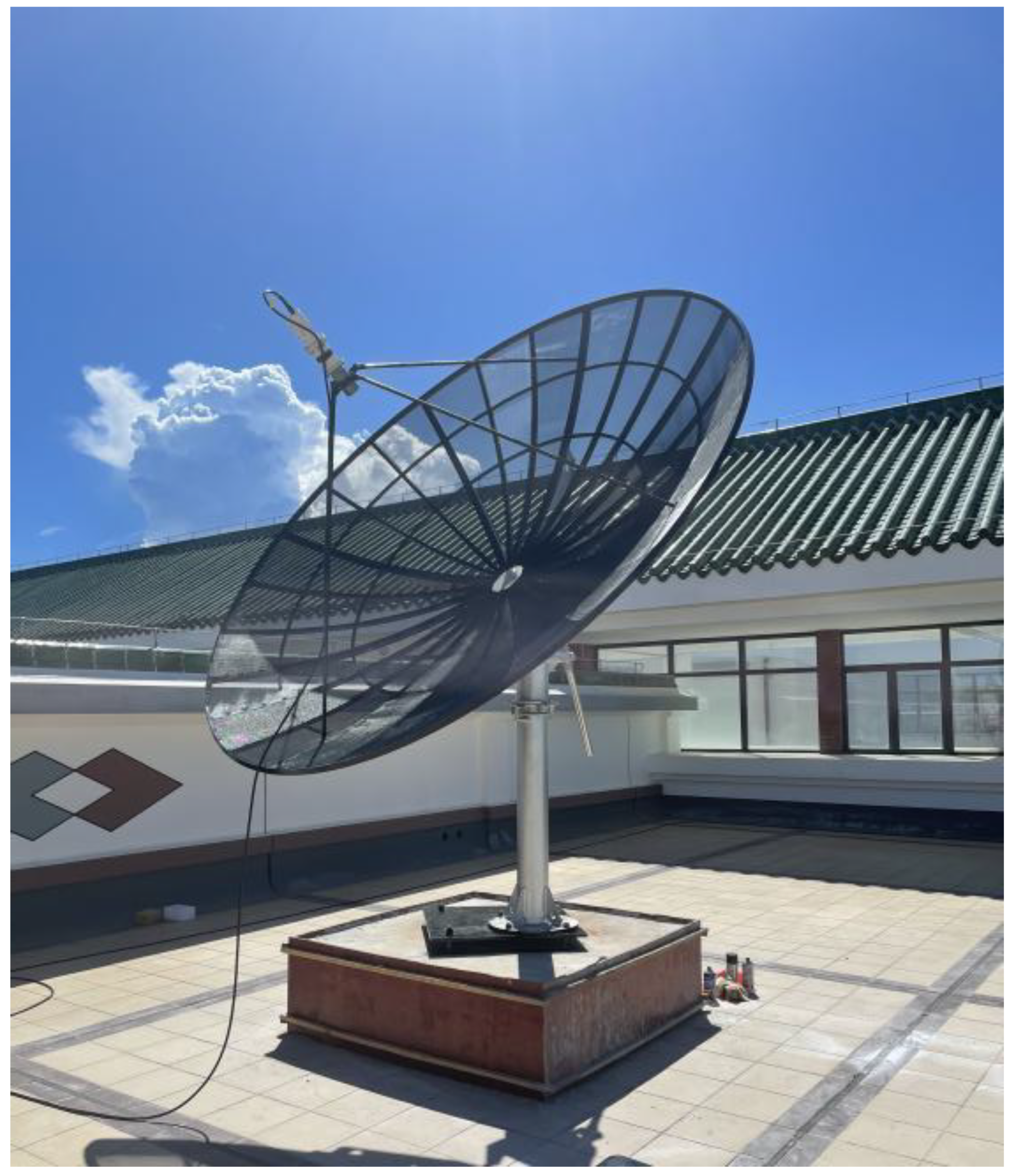
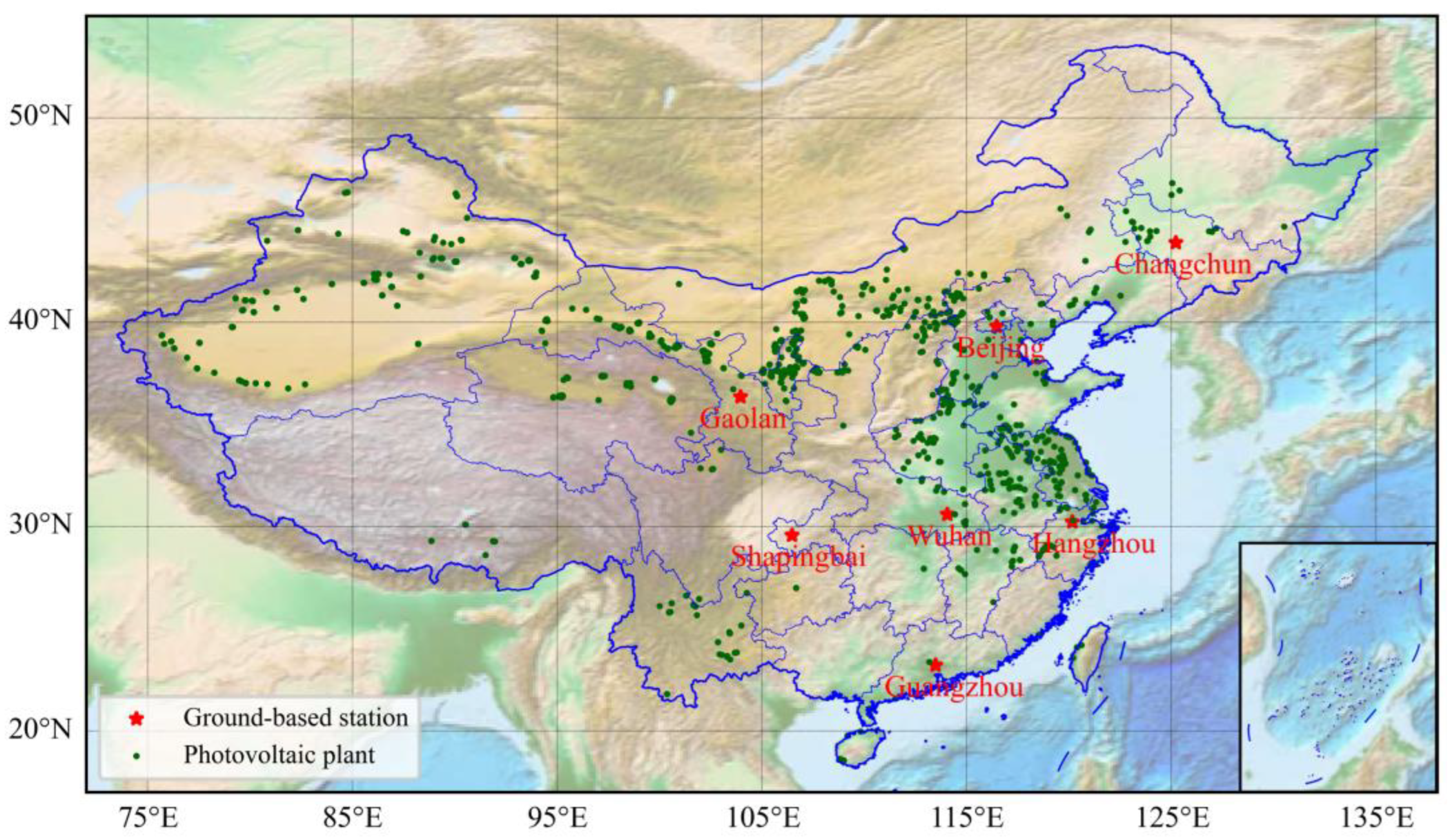

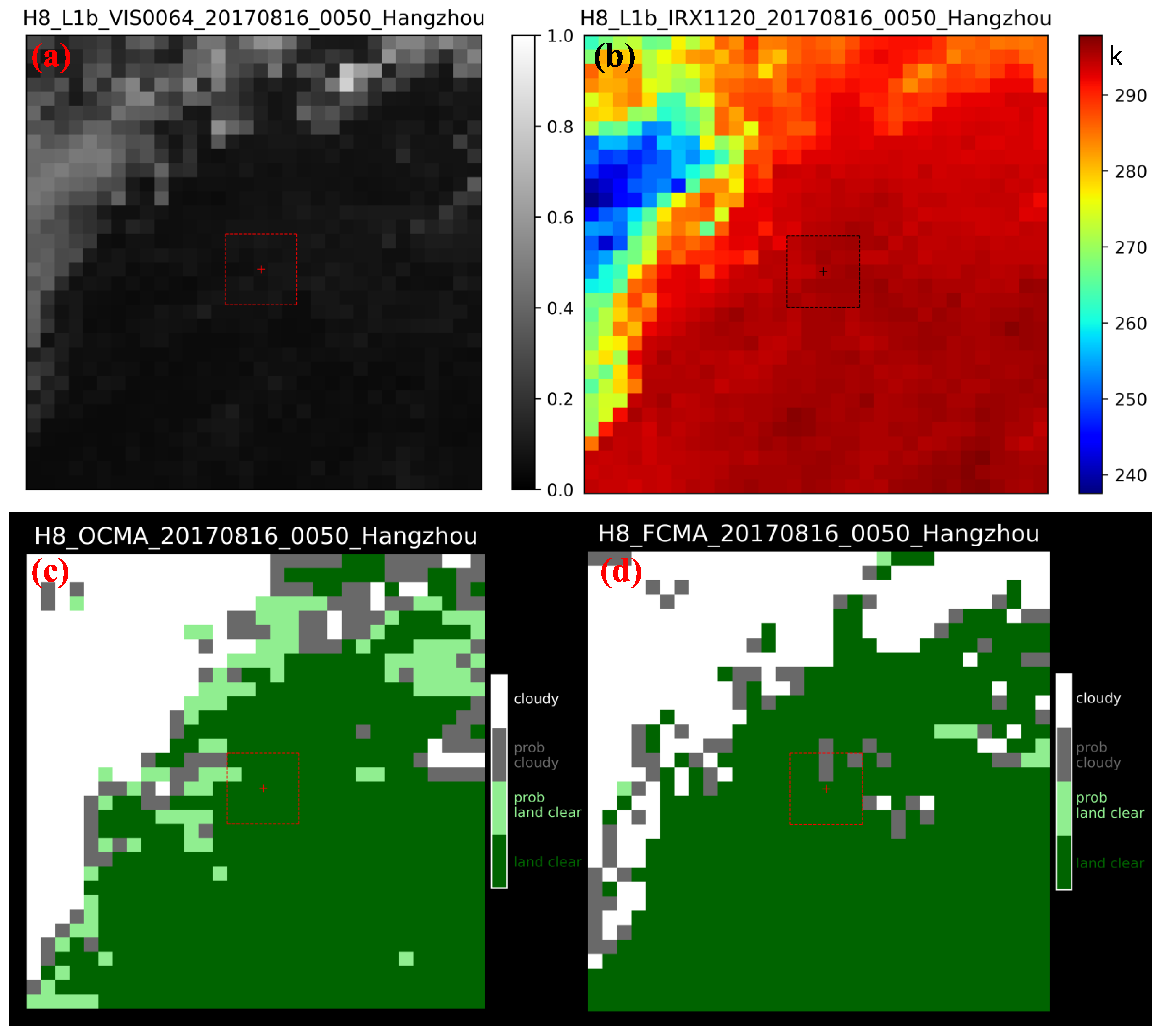
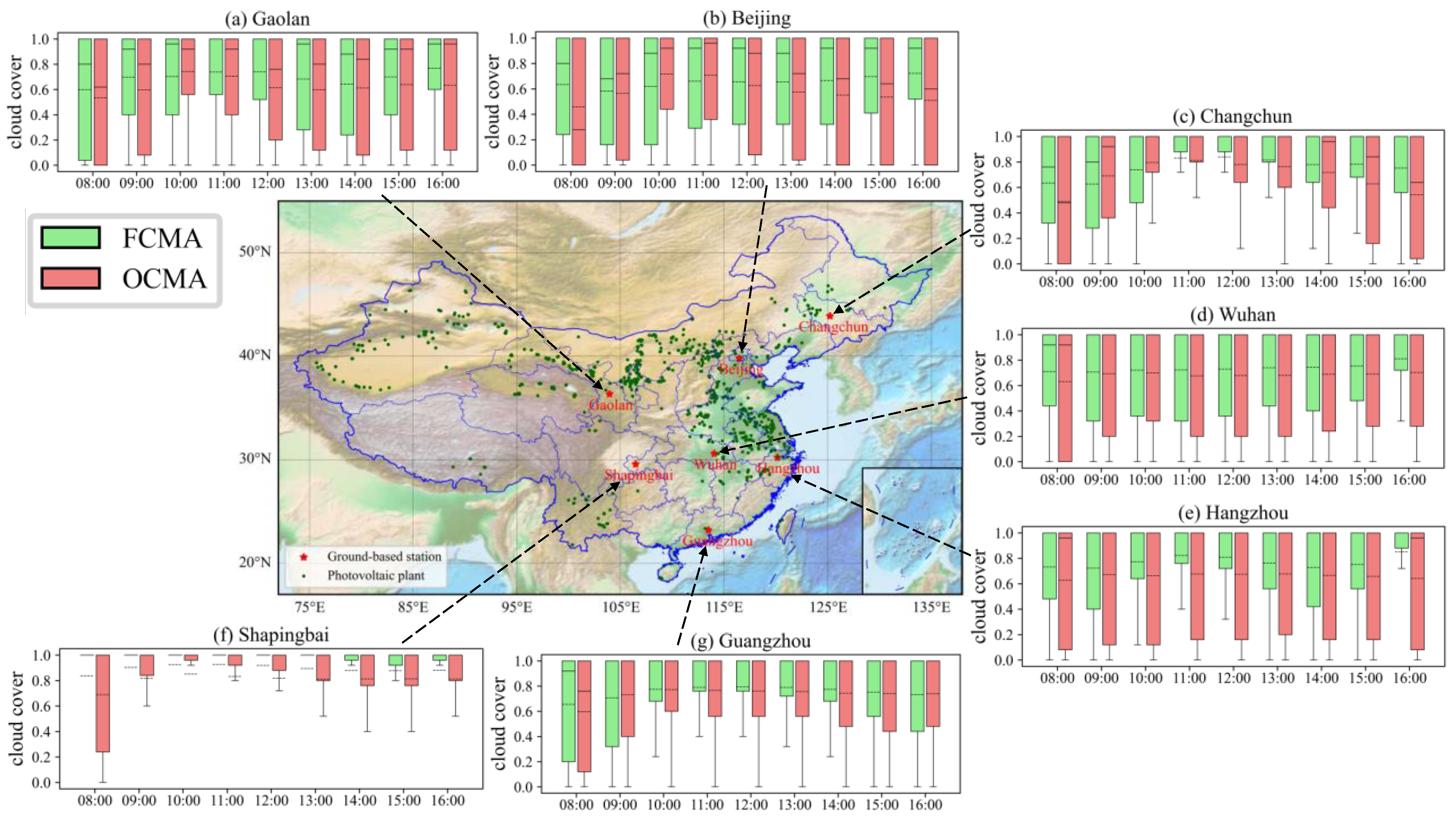
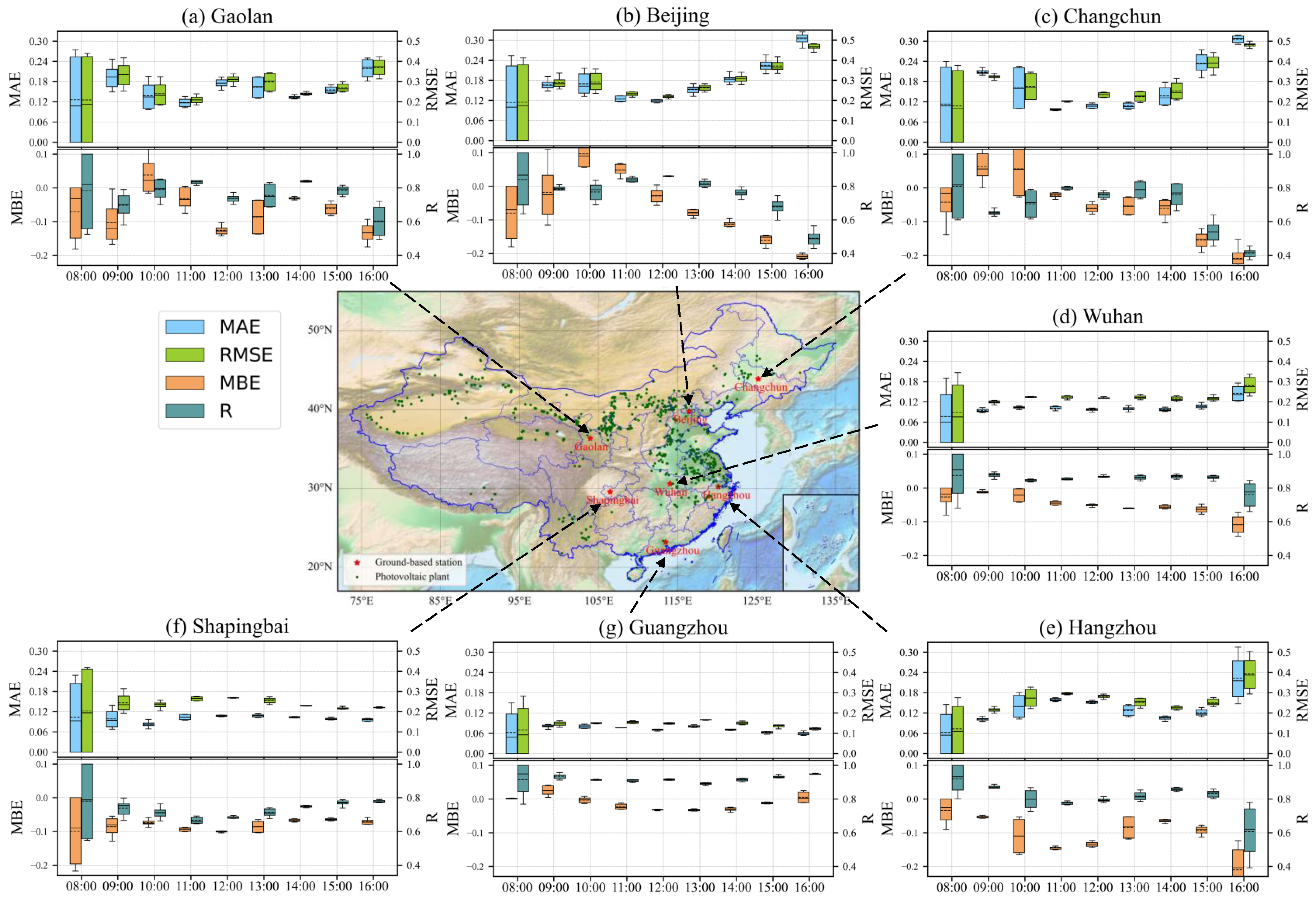
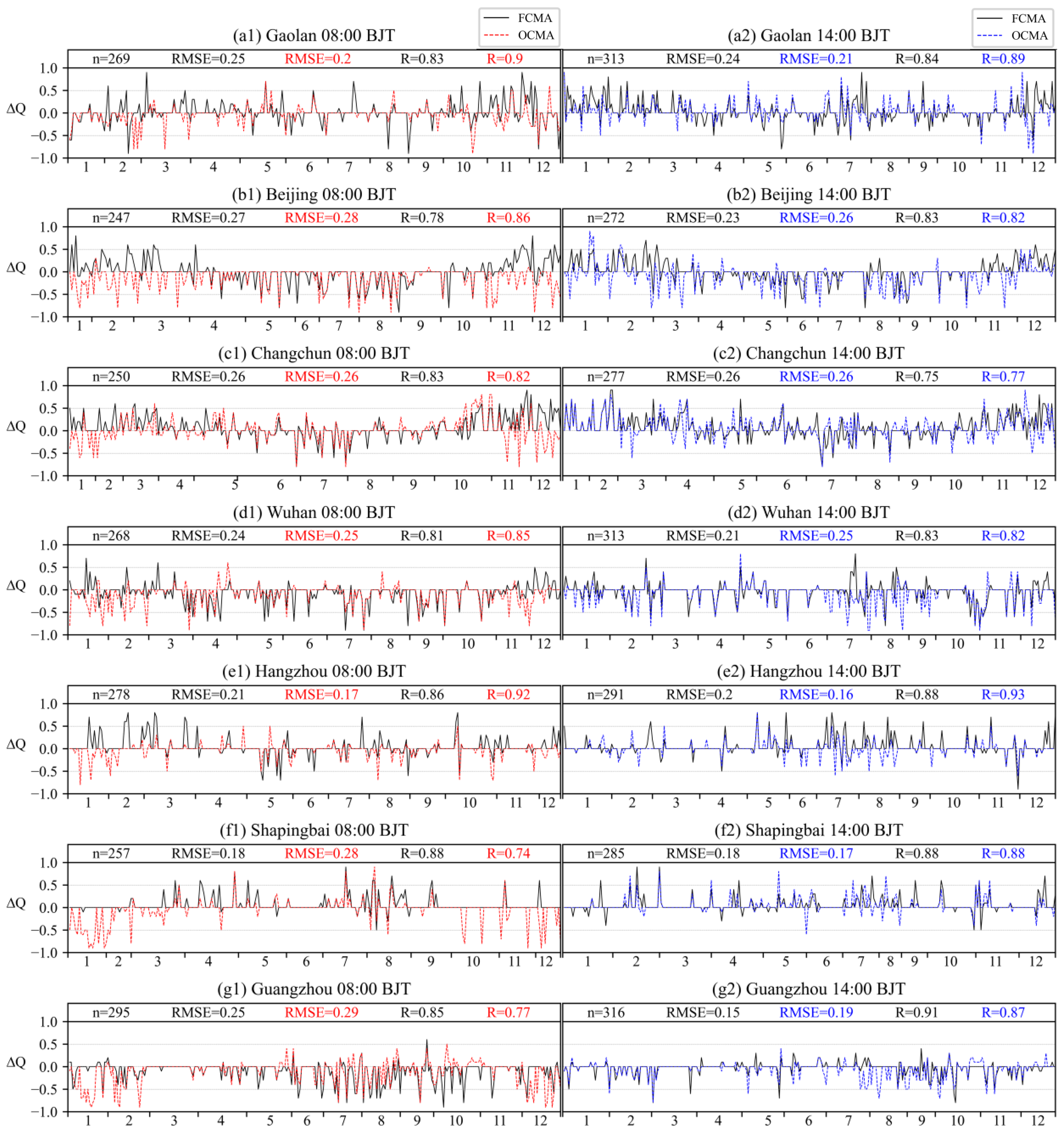
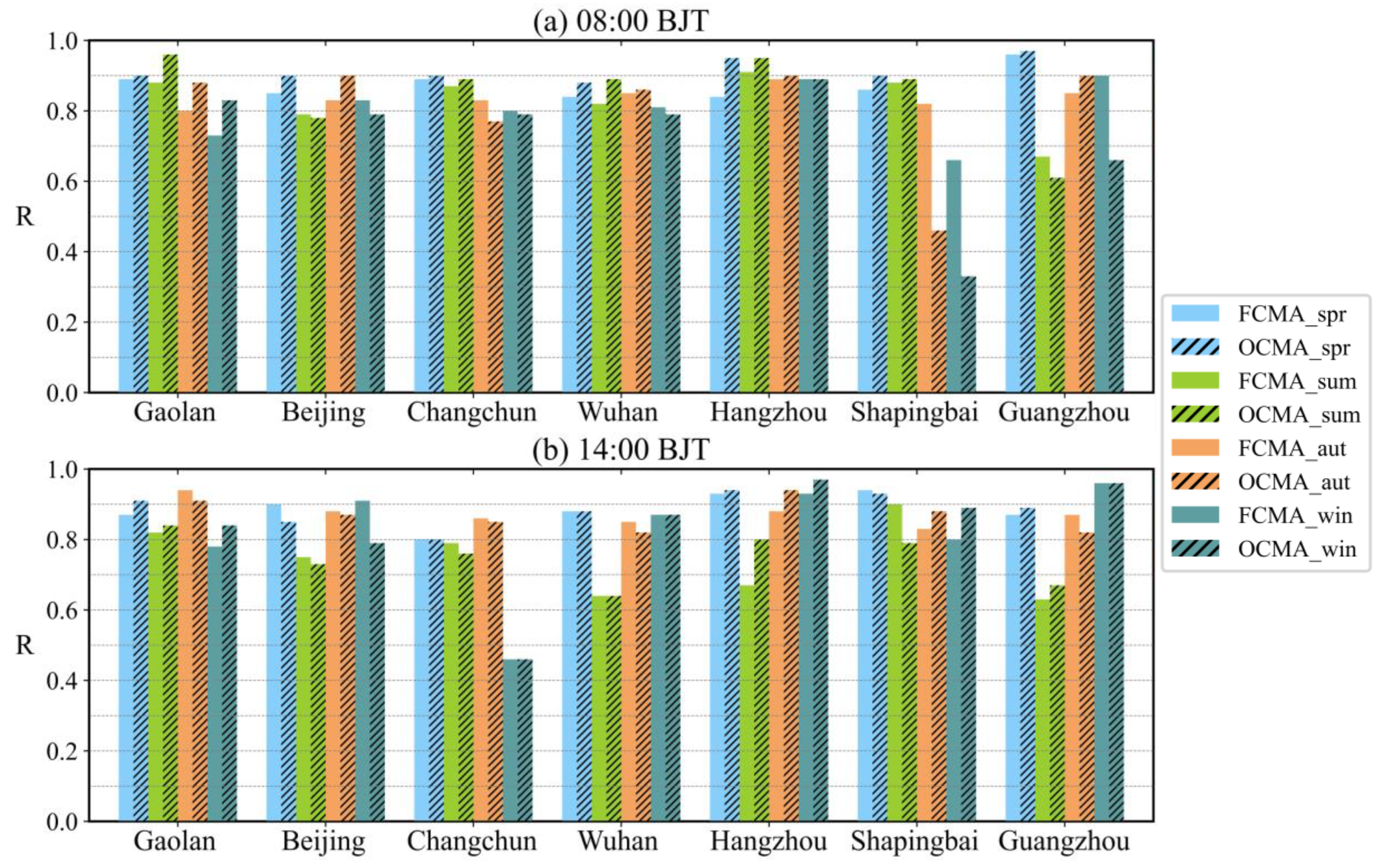
| Station | Coordinate | Surface Type | Climate Type | Altitude |
|---|---|---|---|---|
| Gaolan | (103.95°E, 36.35°N) | Valley and basin | Temperate continental | 1520 m |
| Beijing | (116.47°E, 39.80°N) | Plain | Warm temperate semi-humid and semi-arid monsoon | 43.5 m |
| Changchun | (125.22°E, 43.90°N) | Plain | Temperate monsoon | 300 m |
| Wuhan | (114.05°E, 30.60°N) | Hills | Subtropical monsoon | 23.3 m |
| Hangzhou | (120.17°E, 30.23°N) | Hills | Subtropical monsoon | 19 m |
| Shapingbai | (106.47°E, 29.58°N) | Hills and bench terrace | Subtropical monsoon humid | 400 m |
| Guangzhou | (113.48°E, 23.22°N) | Middle and low mountains | Subtropical monsoon | 4.2 m |
| Stations | Threshold [High, Middle, Low] |
|---|---|
| Gaolan | [0.22, 0.18, 0.14] |
| Beijing | [0.22, 0.18, 0.14] |
| Changchun | [0.22, 0.18, 0.14] |
| Wuhan | [0.20, 0.16, 0.12] |
| Hangzhou | [0.22, 0.18, 0.14] |
| Shapingbai | [0.24, 0.20, 0.16] |
| Guangzhou | [0.22, 0.18, 0.14] |
| Station | Threshold [Low, Middle, High] | |||
|---|---|---|---|---|
| BJT 7:30~09:30 | BJT 09:30~12:30 | BJT 12:30~15:30 | BJT 15:30~16:30 | |
| Gaolan | [1.82, 1.87, 1.92] | [1.84, 1.89, 1.94] | [1.81, 1.86, 1.91] | [1.81, 1.86, 1.91] |
| Beijing | [1.84, 1.89, 1.94] | [1.84, 1.89, 1.94] | [1.84, 1.89, 1.94] | [1.82, 1.87, 1.92] |
| Changchun | [1.85, 1.90, 1.95] | [1.89, 1.94, 1.99] | [1.85, 1.90, 1.95] | [1.90, 1.95, 2.00] |
| Wuhan | [1.81, 1.86, 1.91] | [1.83, 1.88, 1.93] | [1.83, 1.88, 1.93] | [1.85, 1.90, 1.95] |
| Hangzhou | [1.86, 1.91, 1.96] | [1.89, 1.94, 1.99] | [1.89, 1.94, 1.99] | [1.90, 1.95, 2.00] |
| Shapingbai | [1.89, 1.94, 1.99] | [1.90, 1.95, 2.00] | [1.90, 1.95, 2.00] | [1.84, 1.89, 1.94] |
| Guangzhou | [1.84, 1.89, 1.94] | [1.88, 1.93, 1.98] | [1.88, 1.93, 1.98] | [1.83, 1.88, 1.93] |
Disclaimer/Publisher’s Note: The statements, opinions and data contained in all publications are solely those of the individual author(s) and contributor(s) and not of MDPI and/or the editor(s). MDPI and/or the editor(s) disclaim responsibility for any injury to people or property resulting from any ideas, methods, instructions or products referred to in the content. |
© 2023 by the authors. Licensee MDPI, Basel, Switzerland. This article is an open access article distributed under the terms and conditions of the Creative Commons Attribution (CC BY) license (https://creativecommons.org/licenses/by/4.0/).
Share and Cite
Xia, P.; Min, M.; Yu, Y.; Wang, Y.; Zhang, L. Developing a near Real-Time Cloud Cover Retrieval Algorithm Using Geostationary Satellite Observations for Photovoltaic Plants. Remote Sens. 2023, 15, 1141. https://doi.org/10.3390/rs15041141
Xia P, Min M, Yu Y, Wang Y, Zhang L. Developing a near Real-Time Cloud Cover Retrieval Algorithm Using Geostationary Satellite Observations for Photovoltaic Plants. Remote Sensing. 2023; 15(4):1141. https://doi.org/10.3390/rs15041141
Chicago/Turabian StyleXia, Pan, Min Min, Yu Yu, Yun Wang, and Lu Zhang. 2023. "Developing a near Real-Time Cloud Cover Retrieval Algorithm Using Geostationary Satellite Observations for Photovoltaic Plants" Remote Sensing 15, no. 4: 1141. https://doi.org/10.3390/rs15041141
APA StyleXia, P., Min, M., Yu, Y., Wang, Y., & Zhang, L. (2023). Developing a near Real-Time Cloud Cover Retrieval Algorithm Using Geostationary Satellite Observations for Photovoltaic Plants. Remote Sensing, 15(4), 1141. https://doi.org/10.3390/rs15041141







